Just like humans, some dogs have a tendency to gain weight and end up bulging at their seams.
Excess weight can cause a number of different health problems, which will reduce their quality of life and potentially shorten it too.
But it isn’t terribly difficult to help your dog shed a few pounds and reach an ideal weight – in fact, it’s pretty simple. You just need to help her burn a few more calories than she takes in. To do so, you’ll likely need to switch her to a food designed for weight loss, but you’ll also want to get her moving around a bit more.
Below, we’ll explain some of the problems with canine obesity, discuss the things that place a dog at risk of weight gain, recommend dog foods for losing weight, and provide additional suggestions for maximizing your dog’s weight loss to reach an ideal weight.
Check out our quick picks below, or keep reading for more details!
What Makes a Food Good for Weight Loss?
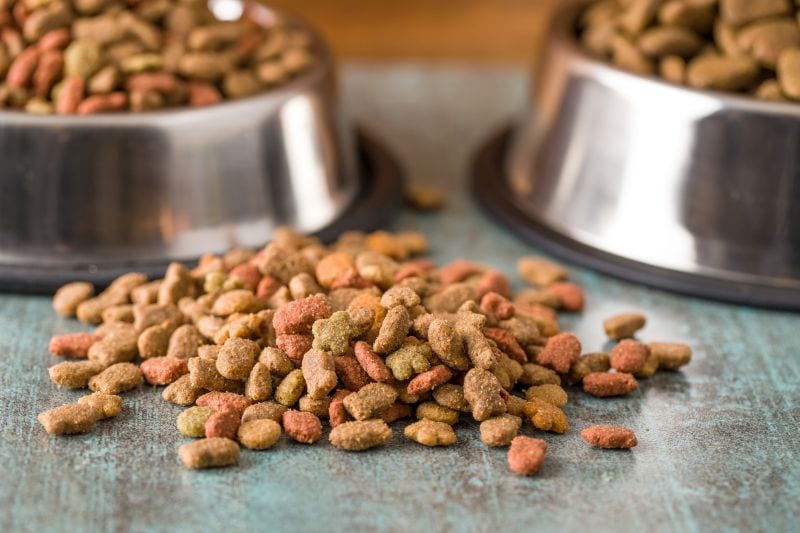
There are a variety of dog foods available that are marketed for weight loss, but that doesn’t mean they are all good choices. Some of the things you’ll want to look for when selecting a food for losing weight include:
Reduced Caloric Content
Most good weight-loss foods have fewer calories than normal foods do.
Just as there is a subset of high-calorie dog foods to help a dog gain weight, there are diets with fewer calories to help a dog shed off pounds too.
Ideally, low-calorie foods will still provide the same amount of bulk so your dog feels full after eating. This is normally accomplished by increasing a food’s fiber content. Fiber contains very few useable calories, yet it takes up plenty of space in your dog’s gut.
Additionally, many foods that are designed for weight loss feature increased protein levels and decreased fat levels. This helps to reduce the caloric content of the food (fats contain more calories per weight than proteins or carbs), while the increased protein helps ensure your dog gets the nutrition she needs.
As a rule of thumb, you’ll want to look for foods with less than 400 Calories per cup, but low-calorie dog food containing less than 300 Calories per cup are even better.
Delicious
A good weight-loss food must still appeal to your pup’s palate, or she may stop eating altogether. Accordingly, you’ll still want to look for foods made with delicious proteins and fats so your dog doesn’t go on a hunger strike.
Nutritious
It is very important that your dog’s food provides the necessary vitamins, minerals, and the appropriate amounts of the major macromolecules (proteins, fats, carbohydrates, and nucleic acids) that she needs to remain healthy. The primary difference between weight-loss foods and normal foods should be caloric content.
Fortified with Probiotics
Probiotics are beneficial bacteria that help your dog’s intestinal tract operate effectively. By selecting foods with probiotics, your dog will be less likely to suffer from intestinal upset as she changes foods, and her body will be better able to digest her food properly.
9 Best Dog Foods for Losing Weight
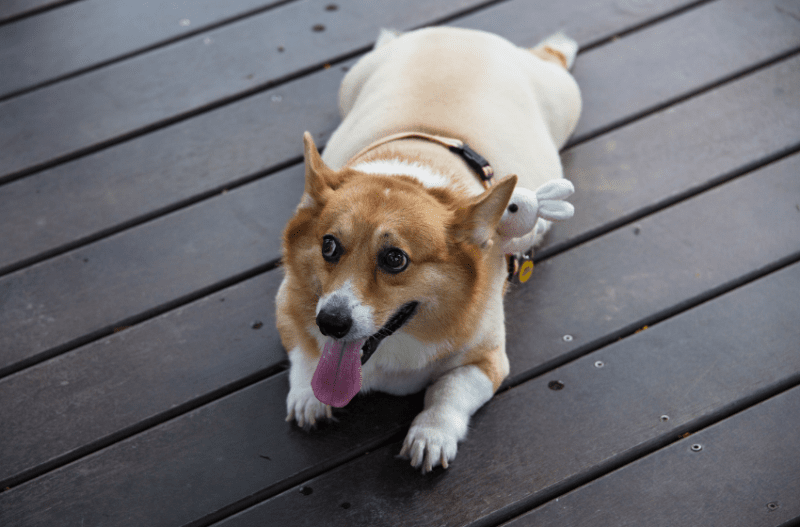
The following nine foods are delicious, nutritious, and tasty, and they should all help your dog to lose a little weight. Just try to select the one that best addresses your pup’s specific needs and discuss your choice with your vet.
1. Wellness Complete Healthy Weight
About: The entire Wellness Complete Health product line has a number of very impressive foods, and their Healthy Weight recipe is no exception with its calorie-conscious recipe featuring fatty acids for skin and coat health. Like all other Wellness Complete products, this chicken-based dog food recipe contains no artificial additives, poultry by-products, or fillers, but as a weight-control formula, it contains less fat and a bounty of fruits and vegetables like spinach, carrots, and blueberries.
Features:
- Packed with premium proteins, including deboned chicken, chicken meal, and whitefish
- Includes whole grains for keeping your pup fuller for longer and fueling energy
- Four different probiotics promote proper intestinal function
- Made in the USA
Calories per Cup: 405
Ingredients List
Deboned Chicken, Chicken Meal, Oatmeal, Ground Brown Rice, Ground Barley...,
Peas, Tomato Pomace, Rice, Ground Flaxseed, Tomatoes, Chicken Fat, Carrots, Natural Chicken Flavor, Potassium Chloride, Choline Chloride, Spinach, Vitamin E Supplement, Taurine, Zinc Proteinate, Mixed Tocopherols Added to Preserve Freshness, Sweet Potatoes, Apples, Blueberries, Zinc Sulfate, Calcium Carbonate, Niacin, Ferrous Sulfate, Iron Proteinate, Vitamin A Supplement, Glucosamine Hydrochloride, Chondroitin Sulfate, Ascorbic Acid (Vitamin C), Copper Sulfate, Thiamine Mononitrate, Copper Proteinate, Chicory Root Extract, Manganese Proteinate, Manganese Sulfate, D-Calcium Pantothenate, Sodium Selenite, Pyridoxine Hydrochloride, Riboflavin, Yucca Schidigera Extract, Garlic Powder, Vitamin D3 Supplement, Biotin, Calcium Iodate, Vitamin B12 Supplement, Folic Acid, Dried Lactobacillus Plantarum Fermentation Product, Dried Enterococcus Faecium Fermentation Product, Dried Lactobacillus Casei Fermentation Product, Dried Lactobacillus Acidophilus Fermentation Product Rosemary Extract, Green Tea Extract, Spearmint Extract.
Pros
- Most owners pleased with their woofer’s weight loss and report increased activity levels
- The ingredient list’s quality is top-notch
- Taste is a win with most doggy diners
Cons
- Fewer calories per cup would be ideal
- Some owners report canine gassiness after feeding
2. Wellness CORE Reduced Fat Grain-Free
About: Wellness CORE’s Reduced Fat Recipe is a grain-free weight-loss dog food containing a wealth of high-value ingredients while still providing a reduced number of calories. Made with almost every dietary bell and whistle an owner could want, Wellness CORE is designed to satisfy all of your dog’s nutritional needs with carbohydrate sources like potatoes and sweet potatoes for satiety, plus fatty acids for skin and coat health from salmon oil.
Features:
- Mixed lean proteins include turkey, turkey meal, chicken meal, and chicken liver
- Rich in antioxidant-rich fruits and vegetables, including blueberries, kale, and broccoli
- Four-part probiotic blend aids in digestion and regularity
- Made in the USA
Calories per Cup: 360
Ingredients List
Deboned Turkey, Turkey Meal, Chicken Meal, Potatoes, Peas...,
Dried Ground Potatoes, Pea Fiber, Tomato Pomace, Chicken Liver, Chicken Fat (Preserved with Mixed Tocopherols), Natural Chicken Flavor, Ground Flaxseed, Salmon Oil, Spinach, Vitamin E Supplement, Broccoli, Carrots, Choline Chloride, Parsley, Apples, Blueberries, Kale, Sweet Potatoes, Taurine, Mixed Tocopherols Added to Preserve Freshness, Zinc Proteinate, Zinc Sulfate, Glucosamine Hydrochloride, Chondroitin Sulfate, Calcium Carbonate, Niacin, Ferrous Sulfate, Iron Proteinate, Beta-Carotene, Vitamin A Supplement, Copper Sulfate, Thiamine Mononitrate, Copper Proteinate, Manganese Proteinate, Manganese Sulfate, D-Calcium Pantothenate, Sodium Selenite, Pyridoxine Hydrochloride, Riboflavin, Chicory Root Extract, Yucca Schidigera Extract, Vitamin D3 Supplement, Biotin, Calcium Iodate, Vitamin B12 Supplement, Folic Acid, Ascorbic Acid (Vitamin C), Dried Lactobacillus Plantarum Fermentation Product, Dried Enterococcus Faecium Fermentation Product, Dried Lactobacillus Casei Fermentation Product, Dried Lactobacillus Acidophilus Fermentation Product, Rosemary Extract, Green Tea Extract, Spearmint Extract.
Pros
- Great low-calorie option for dogs with food allergies to grain
- Most dogs find Wellness CORE very palatable despite the reduced fat content
- Ingredient list is rich in high-quality ingredients
Cons
- Fewer calorie content per cup would be nice
- Mixed protein sources don’t suit sensitive systems
3. Fromm Gold Weight Management Recipe
About: Fromm Gold Weight Management Recipe is a super-premium dog food designed to taste great with healthy fats and vegetables while still helping your pooch to lose extra weight. Free of artificial flavors, colors, and dyes, Fromm Weight Management is full of nutritious ingredients – including a few unusual items — that are sure to please owners and pups.
Features:
- Nutrient-dense turkey liver is the first ingredient
- Mix of meats like duck, chicken meal, menhaden fish meal, and lamb add flavor and protein
- Grain-inclusive recipe includes pearled barley, oatmeal, rice, and millet for energy and satiety
- Made in the USA
Calories per Cup: 341
Ingredients List
Turkey Liver, Chicken Meal, Pearled Barley, Oatmeal, Dried Tomato Pomace...,
Duck, Menhaden Fish Meal, Brown Rice, White Rice, Millet, Chicken, Flaxseed, Pea Fiber, Potatoes, Dried Whole Egg, Salmon Oil, Chicken Fat, Lamb, Cheese, Brewers Dried Yeast, Alfalfa Meal, Carrots, Lettuce, Celery, Chicken Cartilage, Potassium Chloride, Salt, Taurine, Chicory Root Extract, Calcium Sulfate, Yucca schidigera Extract, L-Carnitine, DL-Methionine, L-Tryptophan, Sodium Selenite, Sorbic Acid (Preservative), Vitamins, Minerals, Probiotics.
Pros
- Several pet parents report the food helped their dog shed excess weight and upped their activity levels
- Salmon oil offers omega fatty acids for skin and coat health
- Most dogs seem to love the taste of this pet food
Cons
- It’d be nice to see the included probiotics listed individually
- Mixed proteins can be a problem for sensitive stomachs
- One of the more expensive dog foods for weight loss
4. Dr. Tim’s Weight Management Metabolite
About: Dr. Tim’s Weight Management Metabolite is specifically designed to help speed your dog’s metabolism, thereby increasing her caloric needs. Despite featuring relatively few calories, this recipe is formulated to keep your dog full between meals through the inclusion of several different fiber sources like the prebiotic chicory root and grains like brown rice and whole oats.
Features:
- Chicken meal is the primary protein, followed by salmon meal and chicken liver meal
- Vegetables like dried field peas, spinach, and celery offer vitamins and minerals
- Rich in fatty acids from ground flaxseed and salmon meal
- Made in the USA
Calories per Cup: 269.6
Ingredients List
Chicken Meal, Brown Rice, Whole Oat Groats, Dried Field Peas, Powdered Cellulose...,
Dried Plain Beet Pulp (Sugar Removed), Salmon Meal, Chicken Fat (Preserved With Mixed Natural Tocopherols, A Source Of Vitamin E), Dried Egg Product, Dried Porcine Plasma, Chicken Liver Meal, Whole Ground Flaxseed Meal, Calcium Carbonate, Dried Carrots, Dried Celery, Dried Beets, Dried Parsley, Dried Lettuce, Dried Watercress, Dried Spinach, Salt, Menhaden Fish Oil (Preserved With Mixed Natural Tocopherols, A Source Of Vitamin E), Lecithin (Sunflower Derived), Dried Chicory Root (Source Of Inulin), DL-Methionine, Choline Chloride, L-Lysine, Dried Kelp, Potassium Chloride, Dried Bacillus Coagulans Fermentation Product, Yucca Schidigera Extract, Psyllium Seed Husk, L-Ascorbyl-2-Polyphosphate (Source Of Vitamin C), Calcium Carbonate, Zinc Proteinate, Manganese Proteinate, Copper Proteinate, Zinc Sulfate, Vitamin E Supplement, Ferrous Sulfate, Niacin Supplement, Copper Sulfate, Thiamine Mononitrate, D-Calcium Pantothenate, Vitamin A Supplement, Manganous Oxide, Pyridoxine Hydrochloride, Sodium Selenite, Riboflavin Supplement, Vitamin D3 Supplement, Biotin, Vitamin B12 Supplement, Calcium Iodate, L-Carnitine, Folic Acid.
Pros
- Several owners report their dogs lost weight after switching to the food
- Majority of pet parents are pleased with the food’s quality
- Calorie count per cup is lower than many dog foods for losing weight
Cons
- Doesn’t contain any whole proteins, only labeled meat meals
- Pricing is up there
5. Eagle Pack Reduced Fat Dog Food
A reduced-fat recipe with pork meal as the primary source of protein, plus eight probiotic strains which are not found in most other dog foods.
About: Eagle Pack’s Reduced Fat Recipe is a weight-loss formula that reduces its caloric content by limiting the amount of fat in the food while retaining its taste with a mix of protein sources. Despite having less fat than typical dog foods, Eagle Pack Reduced Fat Recipe still provides all of the nutrition your dog needs to remain healthy while losing weight, plus glucosamine, a cartilage-supporting compound that can help dogs with hip dysplasia and other joint ailments.
Features:
- Pork meal is the primary protein source, but chicken meal and turkey meal are also included
- Grain-inclusive recipe includes dehulled barley, ground brown rice, and oatmeal
- Features eight probiotics strains for a digestion boost
- Made in the USA
Calories per Cup: 343
Ingredients List
Pork Meal, Dehulled Barley, Peas, Ground Brown Rice, Oatmeal...,
Rice, Tomato Pomace, Chicken Meal, Turkey Meal, Flaxseed, Chicken Fat (preserved with Mixed Tocopherols), Brewers Dried Yeast, Potassium Chloride, Inulin, Vitamins [Vitamin E Supplement, Niacin, Vitamin A Supplement, Ascorbic Acid (Vitamin C), Thiamine Mononitrate, d-Calcium Pantothenate, Pyridoxine Hydrochloride, Riboflavin, Vitamin D3 Supplement, Biotin, Vitamin B12 Supplement, Folic Acid], Minerals [Zinc Proteinate, Zinc Sulfate, Iron Proteinate, Ferrous Sulfate, Copper Sulfate, Copper Proteinate, Manganese Proteinate, Manganese Sulfate, Sodium Selenite, Calcium Iodate], Taurine, Calcium Carbonate, Mixed Tocopherols added to preserve freshness, Glucosamine Hydrochloride, Dried Enterococcus faecium Fermentation Product, Dried Bacillus licheniformis Fermentation Product, Dried Bacillus subtilis Fermentation Product, Dried Aspergillus oryzae Fermentation Product, Dried Trichoderma reesei Fermentation Product, Dried Rhizopus oryzae Fermentation Product, Dried Lactobacillus acidophilus Fermentation Product, Dried Lactobacillus casei Fermentation Product, Rosemary Extract, Green Tea Extract, Spearmint Extract.
Pros
- Many owners report their dogs lost weight after starting the food
- Improved energy levels in canines noted by some pet parents
- Great mix of probiotics for digestive health
Cons
- Large kibble size may present problems for small and toy breeds
- The lack of a whole protein is a bummer
- Limited fruits and vegetables compared to other dog foods for losing weight
6. Nutro Ultra Weight-Management Dog Food
About: Made with a blend of three different proteins (salmon, lamb, and chicken), Nutro Ultra Weight Management Recipe is a nutritious weight-loss formula that should help most dogs drop a few pounds.
And although this is a relatively low-calorie food, it contains a number of tasty ingredients to ensure it still pleases your pup’s palate while still proving vitamins, minerals, and antioxidants, plus fatty acids for skin and coat health.
Features:
- Real chicken is the main ingredient
- Grain-inclusive recipe features rice and oatmeal for satiety and energy
- Excellent mix of fruits and vegetables like dried spinach, dried blueberries, and dried apples
- Made in the USA
Calories per Cup: 346
Ingredients List
Chicken, Chicken Meal (source of Glucosamine and Chondroitin Sulfate), Whole Brown Rice, Brewers Rice, Rice Bran...,
Whole Grain Oatmeal, Lamb Meal (source of Glucosamine and Chondroitin Sulfate), Pea Protein, Natural Flavor, Salmon Meal, Chicken Fat (preserved with Mixed Tocopherols), Dried Plain Beet Pulp, Whole Flaxseed, Sunflower Oil (preserved with Mixed Tocopherols), Potassium Chloride, Choline Chloride, DL-Methionine, Salt, Mixed Tocopherols and Citric Acid (preservatives), Whole Chia Seed, Dried Coconut, Dried Egg Product, Tomato Pomace, Dried Kale, Dried Pumpkin, Dried Spinach, Dried Blueberries, Dried Apples, Dried Carrots, Zinc Sulfate, Niacin Supplement, Biotin, Vitamin E Supplement, Iron Amino Acid Chelate, D-Calcium Pantothenate, Riboflavin Supplement (Vitamin B2), Selenium Yeast, Vitamin B12 Supplement, Copper Amino Acid Chelate, Pyridoxine Hydrochloride (Vitamin B6), Manganese Amino Acid Chelate, Vitamin A Supplement, Thiamine Mononitrate (Vitamin B1), Vitamin D3 Supplement, Folic Acid, Rosemary Extract.
Pros
- Most dogs seem to love the food’s taste
- Great mix of proteins for supporting lean muscle health and development
- Loaded with “superfoods” to keep your canine’s immune system operating at peak efficiency
Cons
- Some owners felt the kibblets were too small
- Multiple proteins can be an issue for dogs with food allergies or sensitive stomachs
7. Nulo Adult Weight-Management Cod and Lentils Recipe
This recipe features deboned cod as the primary protein, along with lean turkey meal and salmon. Also is fortified with L-carnitine, an effective fat burner.
About: Nulo Weight-Management Cod and Lentil Recipe is a grain-free, multi-protein recipe designed to help overweight pups shed a few pounds with a collection of dried fruits and vegetables, plus carbohydrates for keeping your canine fueled and satisfied between meals. It will also serve as a great food for dogs who are prone to weight gain, even if they’re still at a healthy body weight.
Features:
- Deboned cod is the first ingredient
- Carbohydrate sources include lentils, yellow peas, sweet potato, and chickpeas
- Fortified with a single probiotic strain — Bacillus coagulans
- Made in the USA
Calories per Cup: 368
Ingredients List
Deboned Cod, Turkey Meal, Salmon Meal, Lentils, Yellow Peas...,
Sweet Potato, Chickpeas, Pea Fiber, Deboned Turkey, Chicken Fat (Preserved with Mixed Tocopherols & Citric Acid), Natural Flavor, Yeast Culture, Dried Chicory Root, Dried Tomatoes, Dried Carrots, Dried Blueberries, Dried Apples, Salt, Calcium Carbonate, L-Carnitine, Choline Chloride, Potassium Chloride, Zinc Proteinate, Vitamin E Supplement, L-Ascorbyl-2-Polyphosphate (Source of Vitamin C), Iron Proteinate, Niacin, Copper Proteinate, Thiamine Mononitrate (Source of Vitamin B1), Calcium Pantothenate, Vitamin A Supplement, Manganous Oxide, Pyridoxine Hydrochloride (Source of Vitamin B6), Sodium Selenite, Riboflavin, Vitamin D3 Supplement, Biotin, Dried Bacillus Coagulans Fermentation Product, Vitamin B12 Supplement, Calcium Iodate, Folic Acid, Rosemary Extract.
Pros
- Contains a great mix of nutritious proteins, fruits, and vegetables
- Several owners report the food helped their dog shed a few pounds
- Fortified with L-carnitine to help canines burn fat more effectively
Cons
- Isn’t the most low-calorie dog food for weight loss
- Grain-free food isn’t a fit for every dog
8. Nutro Natural Healthy Weight Dog Food
About: Another food that is great for portly pups, Nutro Natural Healthy Weight Recipe is a nutritious and delicious food with a very low caloric value. Despite being a low-calorie dog food food, Nutro’s Healthy Weight Recipe is still full of tasty ingredients pups love, such as real chicken and sweet potatoes.
Features:
- Real chicken is the first ingredient
- Whole brown rice keeps woofs fueled for exercise and content between feedings
- Loaded with antioxidant-rich ingredients like dried carrots, dried blueberries, and dried apples
- Made in the USA
Calories per Cup: 228
Ingredients List
Chicken, Chicken Meal, Whole Brown Rice, Lentils, Rice Bran...,
Powdered Cellulose, Split Peas, Brewers Rice, Sweet Potato, Dried Plain Beet Pulp, Dehydrated Alfalfa Meal, Natural Flavor, Pea Protein, Barley, Chicken Fat (Preserved With Mixed Tocopherols), Potassium Chloride, Salt, Choline Chloride, DL-Methionine, Mixed Tocopherols and Citric Acid (Preservatives), Pea Fiber, Zinc Sulfate, Niacin Supplement, Calcium Carbonate, Biotin, Vitamin E Supplement, Iron Amino Acid Chelate, D-Calcium Pantothenate, Riboflavin Supplement (Vitamin B2), Selenium Yeast, Vitamin B12 Supplement, Copper Amino Acid Chelate, Pyridoxine Hydrochloride (Vitamin B6), Manganese Amino Acid Chelate, Vitamin A Supplement, Thiamine Mononitrate (Vitamin B1), Vitamin D3 Supplement, Potassium Iodide, Folic Acid, Rosemary Extract.
Pros
- Pricing is great compared to most dog foods for weight loss
- Several owners report the food helped their pup lose significant amounts of weight
- Reduced calorie content per cup is impressive while still retaining a taste most dogs enjoy
Cons
- The inclusion of lentils is problematic for pet parents concerned about their possible connection to dilated cardiomyopathy (DCM)
- Probiotics would be a nice addition for digestive health
9. Blue Wilderness Healthy Weight Dog Food
About: Blue Wilderness Healthy Weight Dog Food is a grain-free, meat-rich recipe designed to mimic the ancestral diet of wild canines with lean protein sources of real chicken, chicken meal, and menhaden fish meal, plus fruits and vegetables like blueberries, cranberries, and parsley. It has more calories than some of the other weight-loss foods we discuss here, but it is still deserving of serious consideration – especially for dogs who require a grain-free diet.
Features:
- Deboned chicken is the top ingredient
- Primary carbohydrate sources are peas, pea fiber, tapioca starch, and sweet potatoes
- Five probiotic strains promote digestive health
- Made in the USA
Calories per Cup: 353
Ingredients List
Deboned Chicken, Chicken Meal (source of Glucosamine and Chondroitin Sulfate), Pea Protein, Peas, Tapioca Starch...,
Pea Starch, Menhaden Fish Meal (source of Omega 3 Fatty Acids), Pea Fiber, Natural Flavor, Flaxseed (source of Omega 6 Fatty Acids), Powdered Cellulose, Chicken Fat (preserved with Mixed Tocopherols), Dried Tomato Pomace, Dehydrated Alfalfa Meal, DL-Methionine, Potatoes, Dried Chicory Root, Choline Chloride, Alfalfa Nutrient Concentrate, Calcium Carbonate, Dicalcium Phosphate, preserved with Mixed Tocopherols, Sweet Potatoes, Carrots, L-Carnitine, Zinc Amino Acid Chelate, Zinc Sulfate, Vegetable Juice for color, Salt, Ferrous Sulfate, Vitamin E Supplement, Iron Amino Acid Chelate, Blueberries, Cranberries, Barley Grass, Parsley, Turmeric, Dried Kelp, Yucca Schidigera Extract, Niacin (Vitamin B3), Calcium Pantothenate (Vitamin B5), L-Ascorbyl-2-Polyphosphate (source of Vitamin C), L-Lysine, Copper Sulfate, Biotin (Vitamin B7), Vitamin A Supplement, Copper Amino Acid Chelate, Manganese Sulfate, Taurine, Manganese Amino Acid Chelate, Thiamine Mononitrate (Vitamin B1), Riboflavin (Vitamin B2), Vitamin D3 Supplement, Vitamin B12 Supplement, Pyridoxine Hydrochloride (Vitamin B6), Calcium Iodate, Dried Yeast, Dried Enterococcus faecium fermentation product, Dried Lactobacillus acidophilus fermentation product, Dried Aspergillus niger fermentation extract, Dried Trichoderma longibrachiatum fermentation extract, Dried Bacillus subtilis fermentation extract, Folic Acid (Vitamin B9), Sodium Selenite, Oil of Rosemary
Pros
- Most dogs seem to enjoy the taste of this protein-rich recipe
- Many owners report canine weight loss and improved energy
- Several pet parents report improved stool consistency after switching to this food
Cons
- Grain-free diets aren’t for every dog
- Some dogs experienced mild intestinal upset
- Not as low in calories as other dog foods for weight loss
The Problem with Canine Obesity
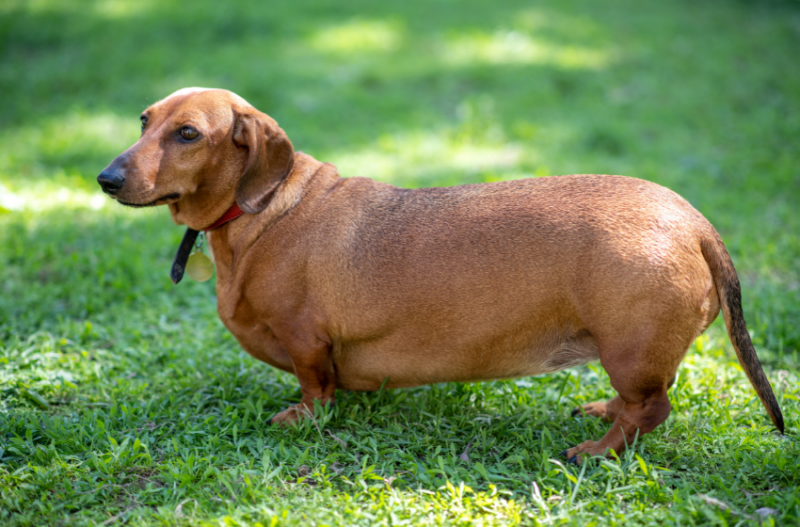
Like most other animals, dogs function best at a relatively narrow weight range. This range obviously differs from one breed to the next, but when any dog gains too much weight, her health will begin to suffer, along with her quality of life.
The most common health and quality of life concerns surrounding canine obesity include:
- Joint Problems. Dogs who are forced to haul around extra pounds place additional wear and tear on their joints. This can lead to arthritis, exacerbate problems like hip dysplasia, and increase susceptibility to sprains and strains.
- Diabetes Mellitus. Overweight dogs have more body tissue than they should, which means that their pancreas cannot produce enough insulin to metabolize the sugars in their bloodstream. If left unchecked, this can cause nerve problems, impair kidney function and shorten your dog’s lifespan.
- Heart Disease. Increased body weight places increased demands on your dog’s heart muscle, which results in inefficient circulation. Additionally, this stress can lead to congestive heart failure, a condition in which your dog’s heart slowly fills with fluid.
- Hypertension. Also known as high blood pressure, this serious medical condition can stress your dog’s internal organs (especially the kidneys) and increase her risk for cardiac problems and stroke. Extra pounds increase your dog’s risk of hypertension.
- Breathing Difficulties. Too much body weight can make it difficult for a dog’s diaphragm to move effectively, which will cause your dog to exhibit labored breathing. This will also reduce the amount of oxygen reaching your dog’s body tissues, which will often cause fatigue and lethargy.
- Liver Problems. Your dog’s body stores some fat in the liver for emergency purposes, but overweight dogs often store too much fat in their liver. This decreases the ability of the liver to function properly, which can cause a variety of subsequent health problems.
- Predisposition to Overheating. The more body fat your dog has, the more body heat she’ll retain. This means that overweight dogs may suffer from higher body temperatures than those of healthy body weight, which can make them feel miserable and avoid activity whenever possible.
- Skin Problems. Skin and coat problems are more common among dogs that carry extra pounds than those who are within their recommended weight range. Additionally, obesity can create skin folds, which can trap oils and dirt and lead to further problems.
- Reproductive Failure. Like most other animals, overweight dogs are at increased risks of reproductive failure. Dogs above a healthy body weight dogs may experience disruptions to their hormonal cycles, and they are more likely to suffer miscarriages or difficult labor than healthy dogs are.
- Increased Cancer Risk. Although scientists do not yet fully understand the causal link between obesity and cancer, research indicates that overweight dogs are at increased risk of developing mammary tumors and bladder cancer.
- Decreased Lifespan. Because of the above-listed problems and others, dogs who are overweight rarely live as long as their healthy counterparts. In some cases, obesity may reduce a dog’s lifespan by several years.
What Causes Dogs to Gain Weight?
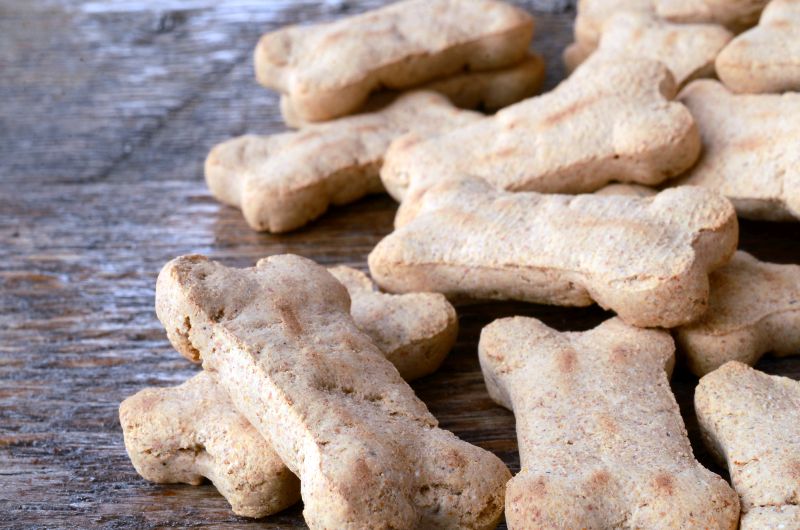
Dogs gain weight for one, and only one, reason: They metabolize more calories than they burn off through exercise. The same principle holds true for all biological systems.
Ingested energy (calories) must be used in some way, and if your dog’s breakfast isn’t used for chasing the mailman, it’ll be used to create additional body tissue – primarily fat.
Now, there are several things that can alter the number of calories your dog requires or change the way in which your dog’s body uses the calories she eats.
For example, just because your dog eats 100 Calories of chicken doesn’t mean her body will extract all 100 Calories — portions of the food may pass through her system intact, and the bacteria in her digestive tract will consume some of the calories.
Additionally, some dogs can utilize more of the calories in a given food than others, some dogs burn more calories while exercising than others, and some foods may even alter a dog’s metabolic rate. So, it isn’t always possible to figure out the exact number of calories your dog is consuming or burning.
But, the ultimate cause for weight gain is an imbalance in the calorie-in / calorie-out arithmetic.
Dogs Predisposed to Weight Gain
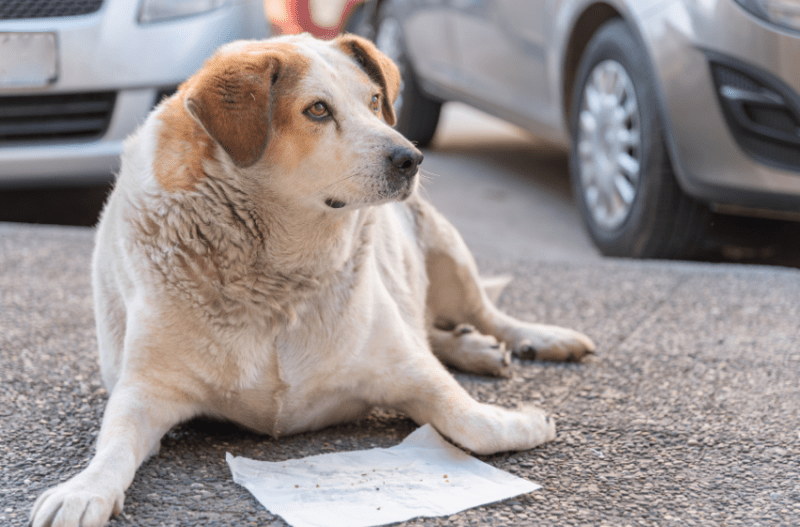
Canine obesity is, as they say, a first-world problem. Wild and feral canines rarely have the chance to consume enough food to gain extra pounds; it is only those dogs who live in the lap of luxury who are realistically at risk of obesity.
The dogs most likely to be above a healthy body weight are:
Older Dogs
A dog’s metabolism normally slows with age, and most dogs will begin to pack on extra pounds more easily as they reach their golden years.
Additionally, older dogs are rarely as active as younger dogs are, which further contributes to weight gain.
Inactive Dogs
Dogs who don’t run, jump, and play very much won’t burn enough calories to remain at a healthy body weight.
Dogs Recovering from Injury or Illness
Dogs who are recovering from injuries or illnesses are rarely able to exercise very much, which can lead to a caloric imbalance and extra pounds.
Dogs with Other Health Conditions
Some medical conditions can affect a dog’s metabolic rate or cause their body to handle their calories improperly. For example, hypothyroidism – a condition in which a dog’s thyroid gland fails to produce the proper amount of hormones – is often associated with weight gain.
Dogs Fed too Many Calories
Dogs who are allowed to eat whenever they want (also known as free feeding) or who are routinely provided with more calories than they need will usually gain extra pounds. This includes things like extra treats, canned food, meal toppers, and other goodies, as those calories count too.
Dogs Taking Some Medications
Some medications can reduce the metabolic rate of dogs or ramp up their appetite – either of which can cause them to store the excess calories they ingest as fat. Corticosteroids, for example, often cause dogs to begin eating more and running around less, and they often cause weight gain.
Altered Dogs
While most people can and should have their dog spayed or neutered, and these procedures typically provide a number of health benefits, altered dogs typically have slower metabolic rates than unaltered dogs do and can pack on extra pounds.
General Dog-Food Buying Guidelines
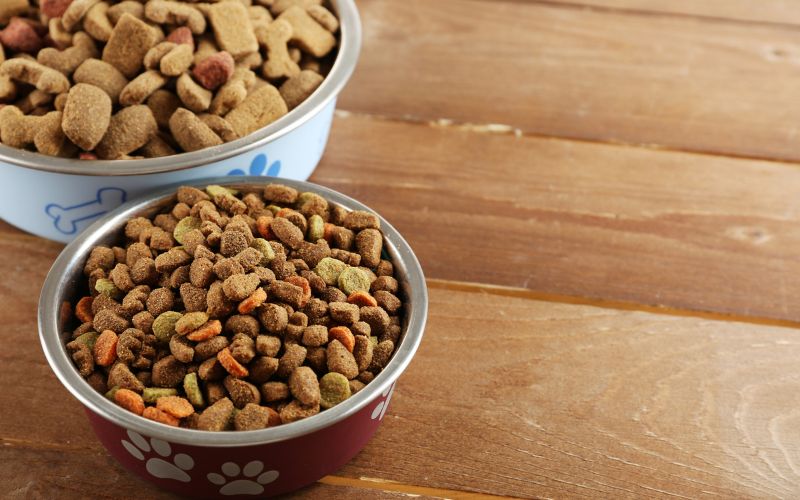
Whether you are looking for a weight-loss formula or a regular dog food, you’ll always want to make sure you select a food that meets a few key criteria. Among other things, you’ll want to look for a food that:
- Was made in a country with high safety standards. This essentially means selecting foods made in the USA, Canada, Western Europe, Australia, or New Zealand.
- Features a whole protein at the beginning of the ingredient list. Dogs are omnivores, but meat should unquestionably form the bulk of their diet, so select foods with things like deboned chicken or beef at the beginning of the ingredient list as protein sources.
- Does not contain artificial flavors, colors, or other additives. Artificial flavors and colors are unnecessary additives for well-conceived foods, and they may trigger canine food allergies. Accordingly, they are best avoided.
- Does not contain unidentified meat meals or byproducts. While properly labeled and identified meat products, such as “chicken meal” and “beef meal” are fine ingredients, you’ll want to avoid things like “meat meal,” which may contain ingredients collected from unsavory sources.
How Many Calories Does Your Dog Need?
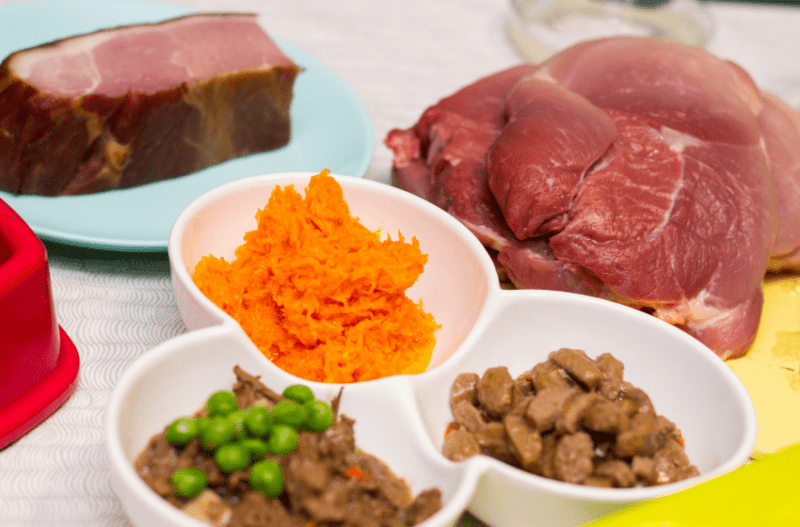
Caloric needs are one of the most important things to figure out when trying to manage your dog’s weight. This will give you a target to guide your feeding practices.
But it isn’t always easy to determine exactly how many calories your dog needs. Individual dogs have different metabolic rates and burn different amounts of calories over the course of a day.
The best way to figure out your dog’s caloric requirements is by first determining her Resting Energy Requirements (RER). This tells you the number of calories your dog needs to breathe, pump blood and perform other critical body processes.
To determine a dog’s RER, you raise her body weight in kilograms to the ¾ power (to convert your dog’s weight in pounds to kilograms, just divide her weight in pounds by 2.2). This number is then multiplied by 70, which gives you the number of Calories she needs per day.
To borrow an example from Ohio State University Veterinary Medical Center:
A 10-kilogram dog = 70(10)3/4 = 400 Calories = RER
This number (the RER) is then multiplied by one of several factors to arrive at her true caloric needs.
For example:
- Puppies have a factor of 2.0 to 3.0, depending on their age.
- Unaltered adults have a factor of 1.8
- Spayed or neutered adults have a factor of 1.6
So, assuming our original 10-kilogram dog is a spayed adult, she’d need about 640 Calories of food each day. If she were not spayed, she’d need a few more calories, totaling about 720.
Overweight dogs should use a factor of 1 when determining their daily caloric needs. Also, the RER should be determined using her ideal body weight.
This means that if our 10-kilogram dog is about 2 kilograms overweight, the formula would be:
70(8)3/4 = 332 = RER
Multiplying this by a factor of 1 means that she’d need to eat about 332 Calories per day to lose weight safely. As a ballpark figure, many vets recommend cutting the daily caloric intake of overweight dogs by about 25%.
But I can already hear you thinking: That’s too much math. How the hell do you raise something to a fraction, anyway?
Fortunately, you don’t have to worry about this if you don’t want to. Instead, you can just consult a body weight chart, like this one, published by the World Small Animal Veterinary Association.
Again, all dogs are individuals, and the formula and chart referenced above should only be used to arrive at an estimate. Your dog’s actual caloric requirements may differ from this figure by 50% in some cases.
How Do I Know if My Dog Is Overweight?
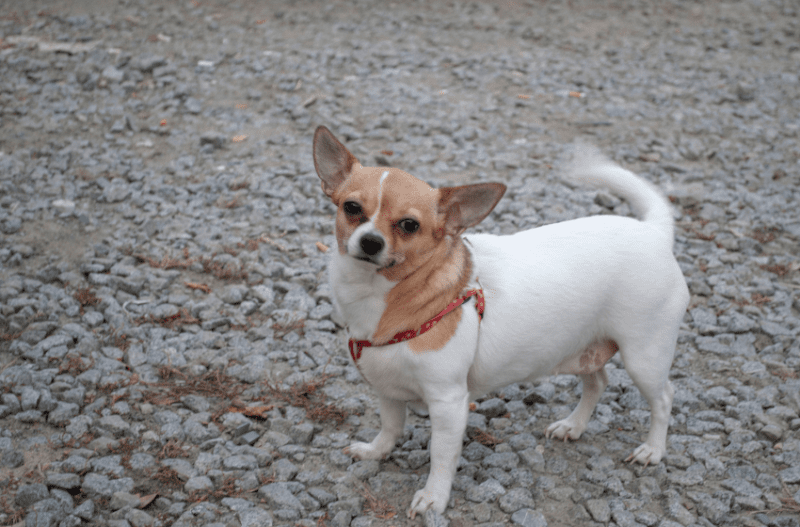
Always take your dog in for a veterinary visit if you suspect she is overweight. That way, he or she can make a determination and help identify potential causes and illuminate appropriate treatment solutions, such as reduced food intake of her current food or a lower-calorie option than typical dog foods.
However, there are a few things you can consider when trying to decide if your pet is overweight. The first is to compare the standard of her breed against her body weight. If she exceeds the average weight of her breed (for her height), then she is – by definition – overweight. The term “obese” only applies when a dog’s body weight is 10% to 15% above a healthy body weight.
It can also be helpful to consult a Body Condition Score Chart (like this one) to determine if your dog is overweight.
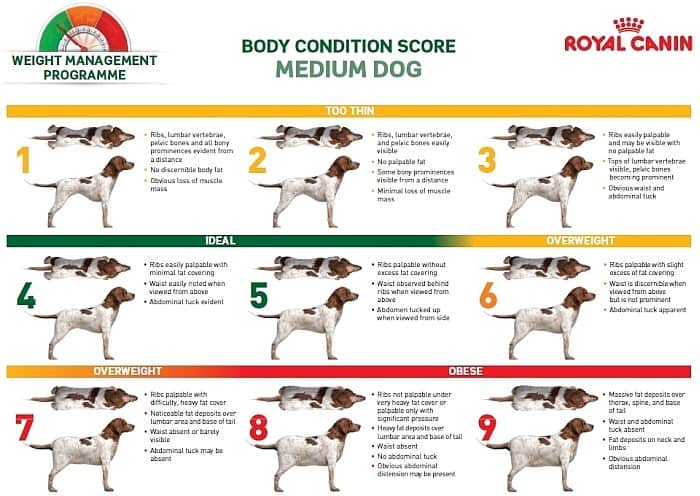
Other Things You Can Do to Help Your Dog Lose Weight
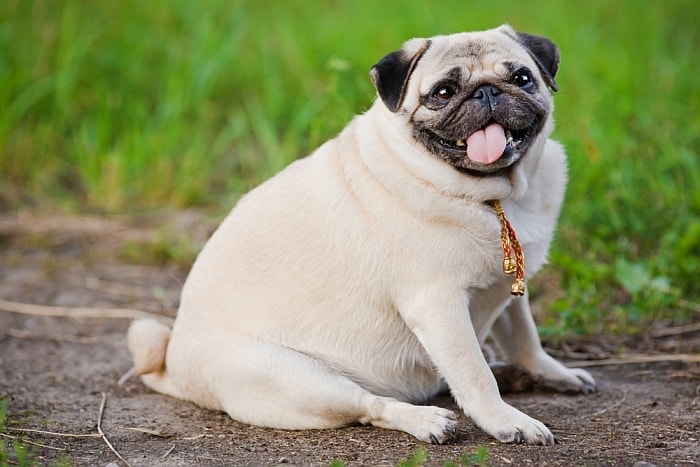
Switching to weight-loss dog food is a great way to help your pooch lose her paunch, but it isn’t the only way to achieve results. You can also use the following strategies and techniques to help her slim down.
Increase the Amount of Exercise She Gets
If caloric intake is one side of the body weight coin, exercise is the other. By increasing the amount of exercise your dog receives, you’ll also increase the number of calories she needs on a daily basis. But, if you don’t increase her food intake, she’ll have to fuel her body by burning stored fat.
Just be sure to start any exercise regimen gradually to avoid causing injuries. Don’t just head out for a 5-mile run with your couch potato canine. Start with short walks and gradually increase their length.
Stop Feeding Treats
Many owners neglect to consider the calories they provide in the form of treats or canned food mix-ins. This is especially problematic for small dogs, for whom each treat represents a significant percentage of their daily caloric intake. In cases where your doggo needs a reward, offer healthy options with a lower caloric density, such as fresh vegetables.
Stop Feeding People Food
While there’s probably nothing wrong with giving your dog the occasional French fry, owners who routinely feed pups high-calorie people foods are setting their dog up for health problems. Human food has higher fat levels and caloric density than canine cuisine, leading to weight gain and possible belly upset in dogs. Generally speaking, you’ll want to feed your pooch dog food and avoid table scraps.
Visit Your Veterinarian
You’ll always want to keep your vet in the loop if you are trying to help your dog shed a few pounds, and your vet may be able to provide additional assistance. For example, some overweight dogs suffer from medical problems that cause them to gain weight, and medications may help correct these types of problems.
Best Dog Foods for Losing Weight: FAQ
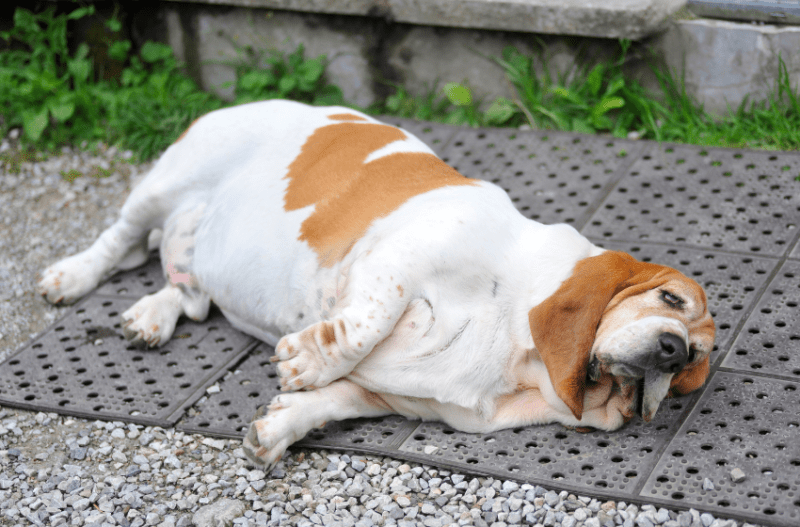
Have lingering questions about the best dog foods for losing weight? Curious about something related to weight-control formula foods? Check out these commonly asked questions surrounding the subject.
How much weight loss food should I feed my dog?
The amount of food your dog needs will vary by her size and the type of food you’re offering, as every recipe has its own calorie count and nutrients. Follow the feeding instructions on the food of your choice, or consult your vet.
What are the best low fat dog foods?
The best low-fat dog food for your dog will depend on her dietary needs and life stage, but Eagle Pack’s Reduced Fat Recipe is a solid pick for most canines. Another good option is Wellness CORE’s Reduced Fat Recipe if your dog needs a grain-free diet. Like any grain-free option, ask your vet before serving Wellness CORE.
When browsing for low-fat dog food, look for one that uses high-quality ingredients, such as whole meat as the first ingredient and primary source of protein, and one featuring quality grains like barley over corn germ meal or grain corn. You’ll also want to avoid artificial flavors and colors that can upset sensitive stomachs.
What is the best thing to feed a dog to lose weight?
The best thing to offer your dog to lose weight is a properly measured portion of food, for one, as many of today’s pets are overfed, whether through free-feeding from a full food bowl or given too much at mealtime. This also means limiting treats or switching to healthy options like fresh vegetables.
Another great option is to serve dog food meant for losing weight. Look for a weight-control formula that’s lower in calories and fat than standard kibble and feed the amount indicated for your dog’s size on the packaging. The best weight-control formulas feature a whole protein as the first ingredient, grains for satiety, and plenty. of nutrient-rich fruits and vegetables.
As with any dietary change, it’s always best to consult your vet before switching your pup’s food, especially if your dog’s weight gain is sudden or unexplained.
What is the fastest way to get a dog to lose weight?
The fastest way to help your dog lose weight is to properly measure her food portions and increase her daily exercise. You can also switch to dog food designed for weight control, such as Wellness Complete Healthy Weight. Dog foods for losing weight are formulated with fewer calories and fat, helping four-footers shed excess weight.
As always, speak with your vet before implementing any major dietary or exercise changes to ensure they suit your dog’s needs and are done safely.
Do green beans help dogs lose weight?
Green beans are a great snack for woofers on a weight loss journey. They have a taste and texture most dogs love and can be served frozen or raw. They’re a good source of fiber, aiding in healthy digestion, plus they have nutrients like manganese, folate, and Vitamins A, C, and K.
Be sure to skip canned green beans, as they’re full of salt. It’s also important to note that, yes, beans cause gas, too, so don’t overload your dog’s food bowl with them, especially if he’s a gassy dog breed.
What dog food is good for an overweight dog?
Weight control or maintenance dog foods are ideal for overweight dogs or pups prone to weight gain. These specially-formulated foods still feature the same nutrients dogs need, like premium protein, just with fewer calories and fat per serving.
Is grain free dog food better for weight loss?
No, grain-free foods aren’t better for canine weight loss. In fact, many grain-free foods are more calorically dense than grain-inclusive options, leading to weight gain in dogs if you’re not careful. They’re also not healthy options for every dog, as they’re potentially linked to a dangerous heart conditions called dilated cardiomyopathy.
Always check with your vet before switching your dog’s food, but especially if you’re eyeing grain-free foods, as they aren’t right for every canine. This is particularly important if your dog’s breed is prone to dilated cardiomyopathy, like Dobermans and Great Danes.
Has your dog ever had an issue with weight gain? What kinds of things did you do to help her burn off some of her pudge? Did you switch foods to any of the dog foods for losing weight we listed or begin an exercise regimen?
Let us know all about your experiences in the comments below.
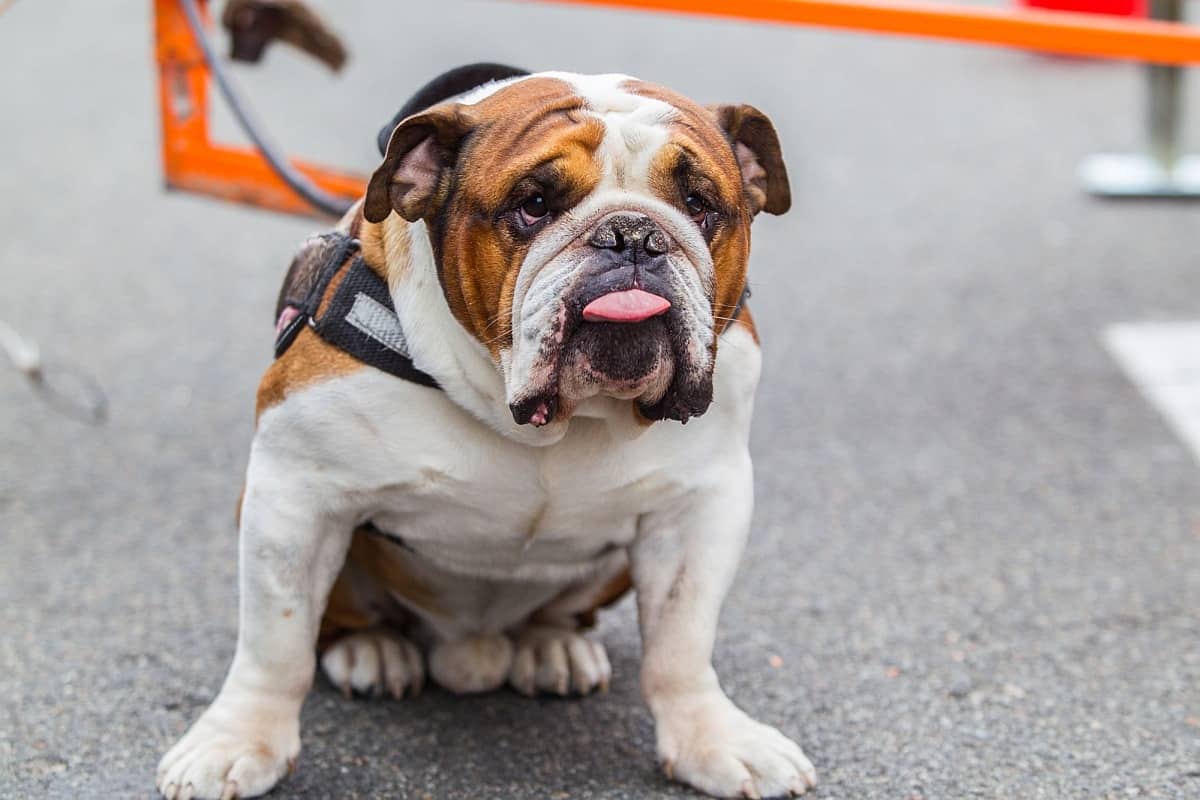
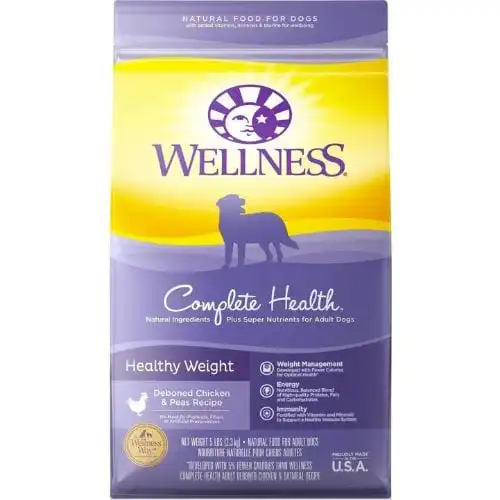
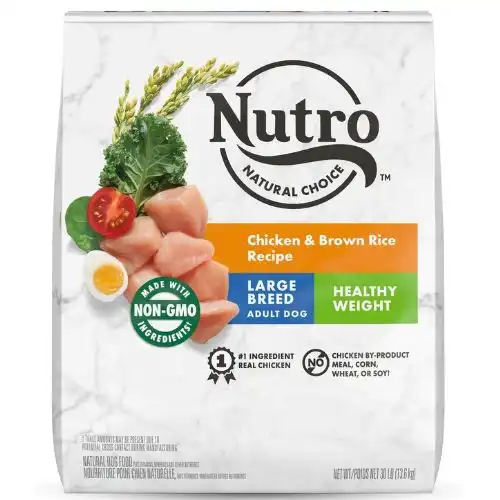
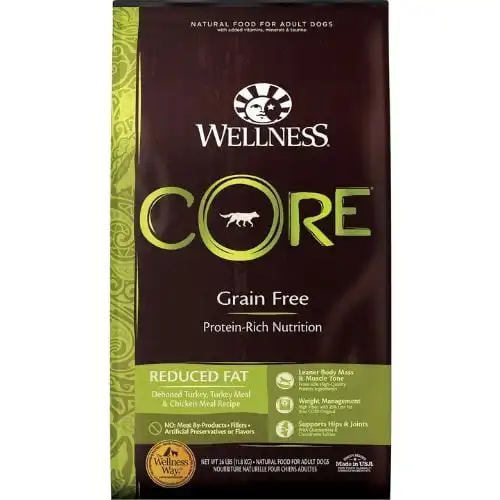
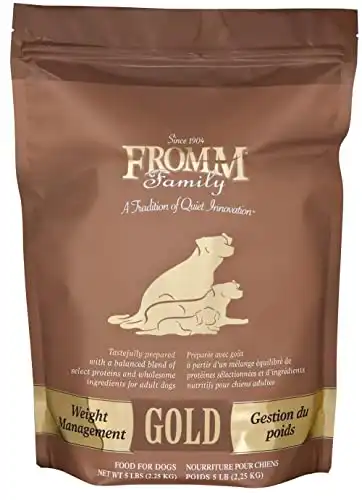
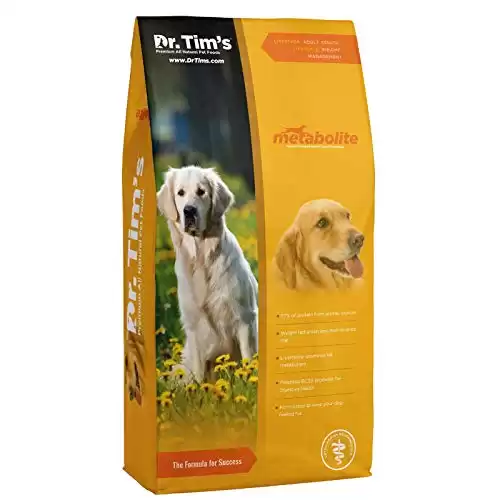
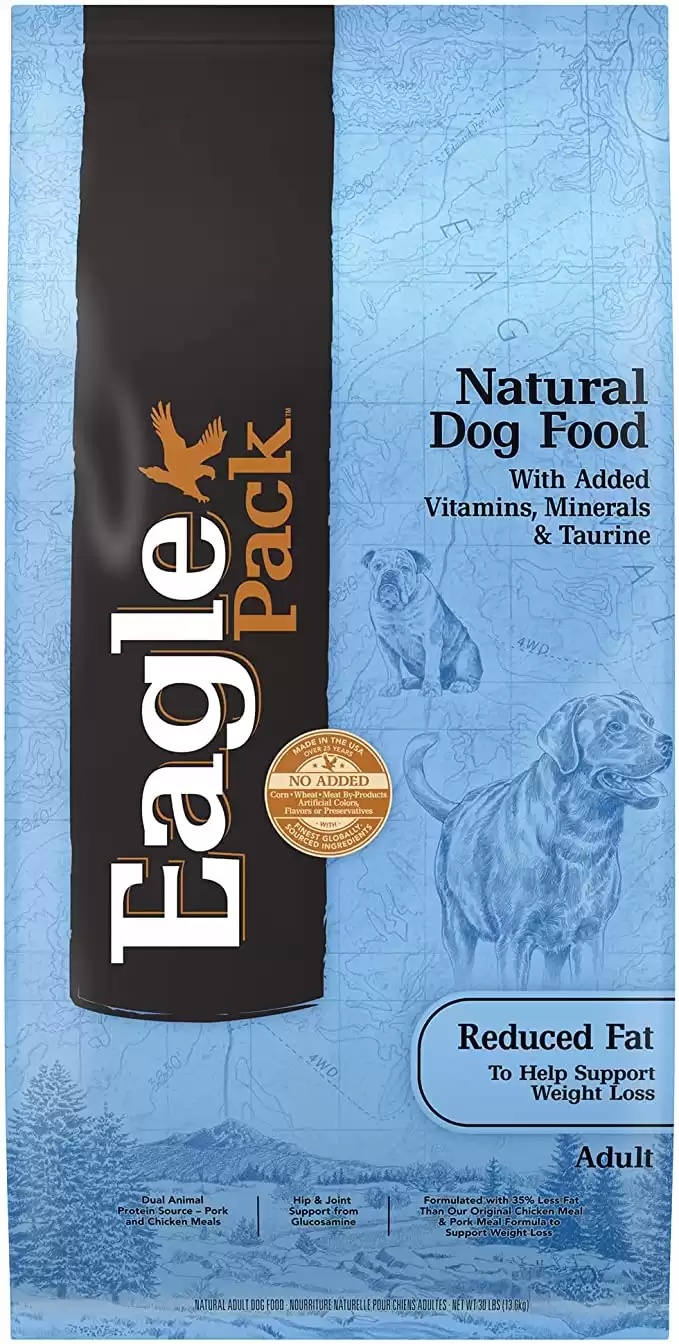
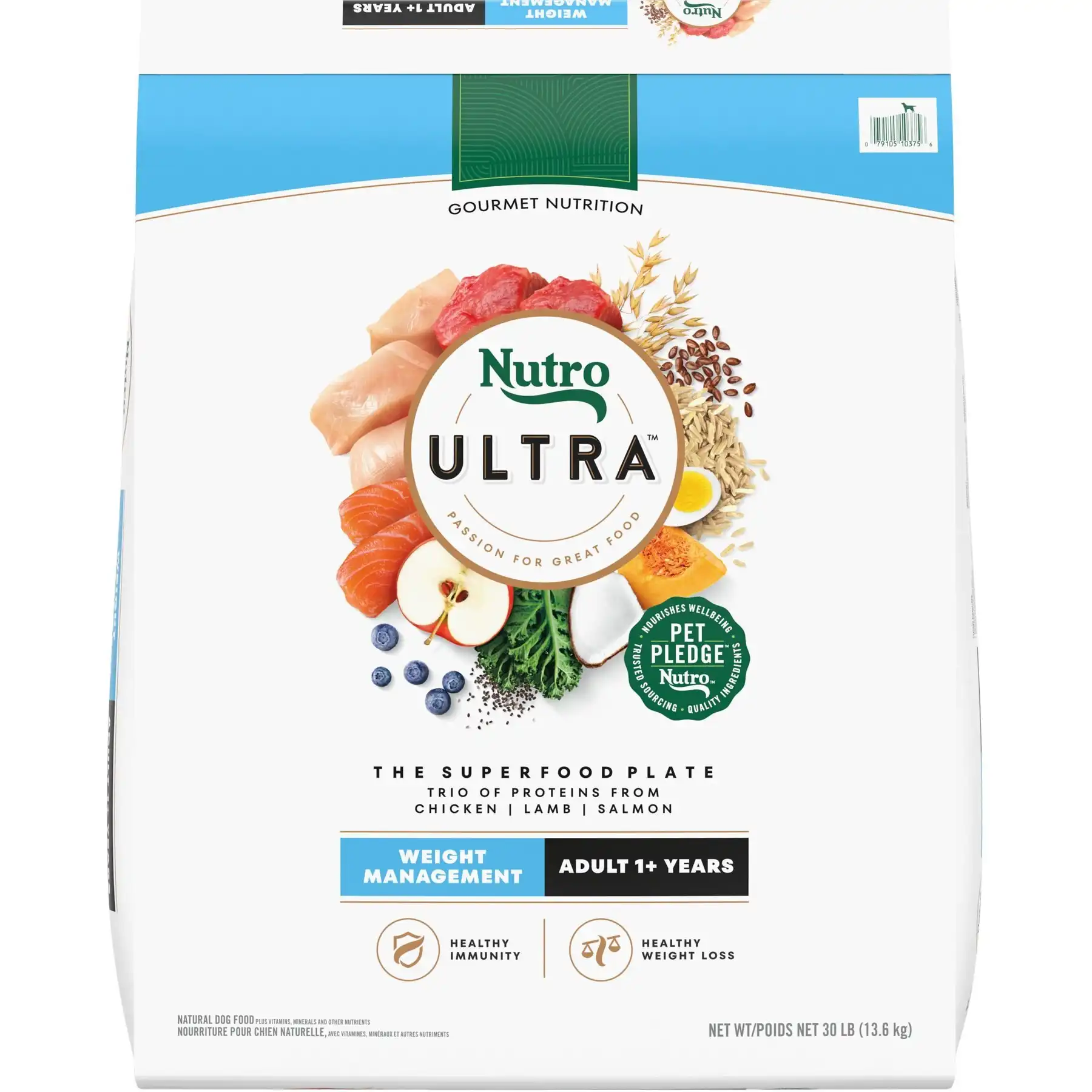
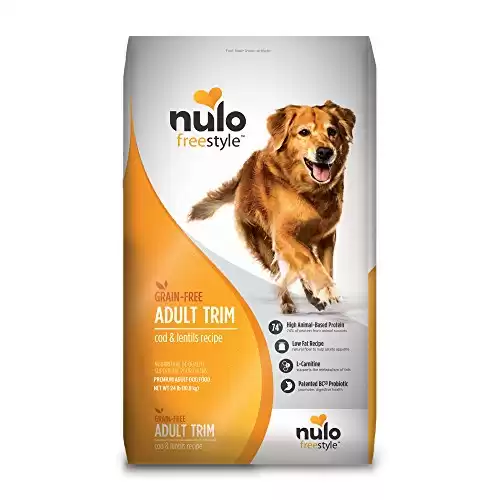
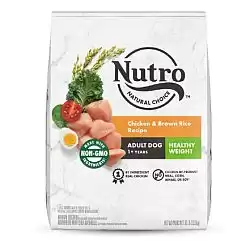
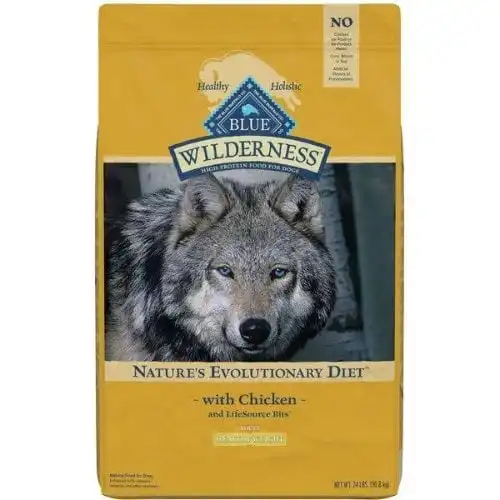



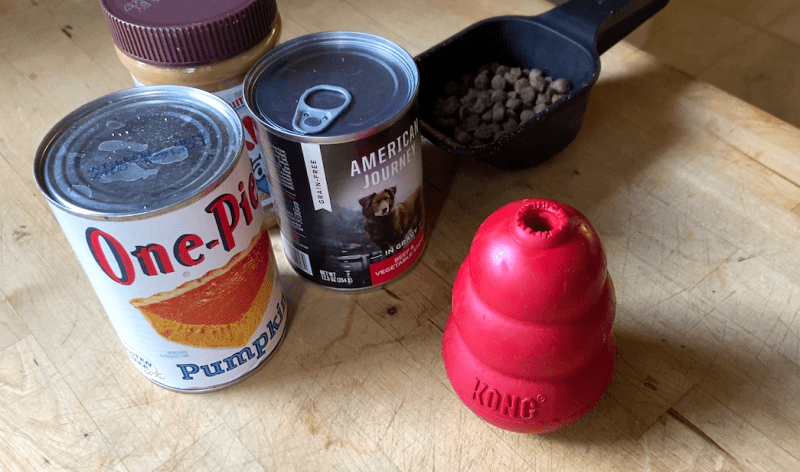
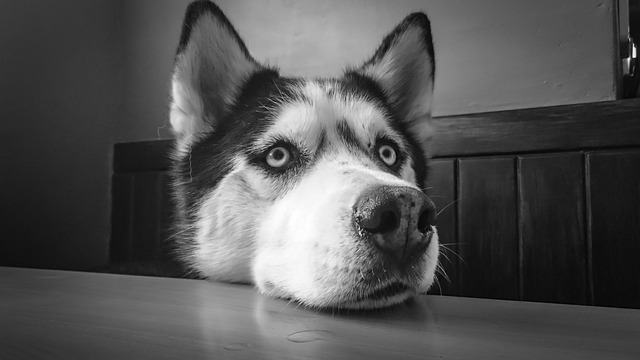
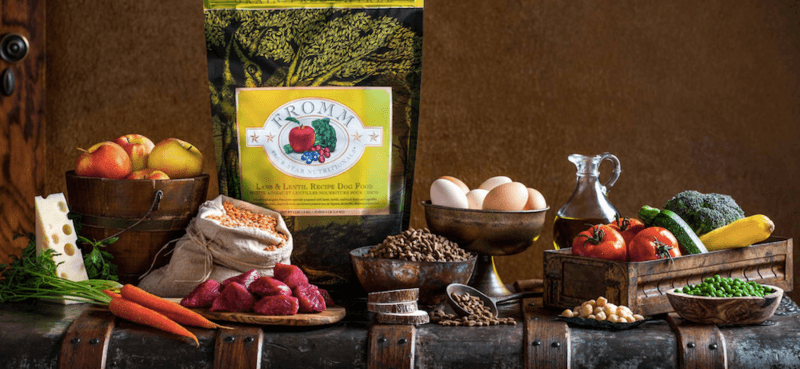

Leave a Comment